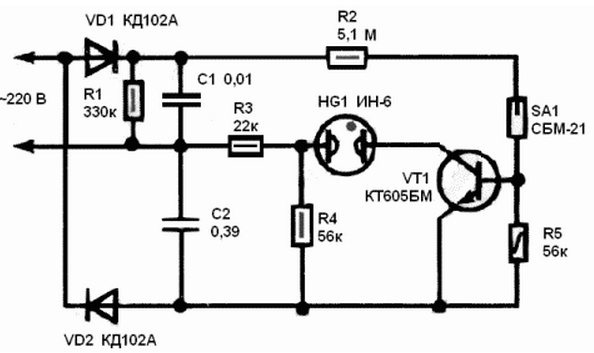To answer the question out the simple indicator. He warns not only about the level of background radiation, but also help to check on the pollution of water, soil, food.
As you can see, the scheme of the device is simple. Its essence is the sensor of ionizing radiation. It is a small cylindrical glass flask filled gas, with two electrodes at the ends. The sensor circuit is included in the base of the transistor VT1, managing the inclusion of neon light, HG1. To its electrodes attached high, about 600 V DC. To get it, use the voltage doubler diodes VD1, VD2 and the capacitors C1, C2.

Radioactivity indicator
When no ionizing radiation, the resistance between the electrodes of the sensor is equal to infinity, the transistor VT1 is locked and the light HG1 not lit. But here ran between the electrodes of a charged particle in gas filling the flask, the ionized channel. As you know, conducts current. The transistor immediately open, and for a short time will light the bulb. The more charged particles will run through the sensor, the more often it will flare up.
Now a few words about the details. In the scheme of the indicator can be used in diodes type CD, transistors CT with any letter index. As the indicator suitable neon lamp IN-6 or T-0,2. The sensor of ionizing radiation may be of any type, designed for a working voltage of 360-W - for example, SBM-21, SBM-11, SBM-20, STS-20 or STS-5.
Structurally, the device to perform better in the case of hardboard or plastic. Opposite the place where will be located the sensor in the side of the hull provide a small a rectangular hole, and cover it with polyethylene. The efficiency of the device determined by the flashes of a neon lamp. Remember that the scheme is high voltage! So when building and repairs do not forget to disconnect the device from network!
Author: V. Kubyshkin






